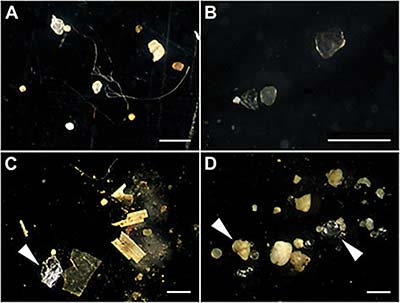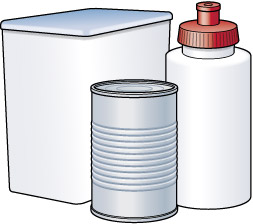9 Scientific research continues to develop
Scientific research is always developing in a range of directions, as you heard when listening to the interviews with four OU scientists in Section 3. This requires us to carefully evaluate the science and how it is reported. To demonstrate this, some research relating to plastics will now be considered here.
In the environment, plastic materials tend to break down slowly, often by UV degradation or physical fragmentation, to produce smaller particles or microplastics like those shown in Figure 6. Note the diverse shapes (filaments, fragments, and spheres) and that not all items are microplastics (e.g. aluminum foil (C), glass spheres and sand (D), white arrowheads).

Microplastics form the subject of a great deal of current research, such as the review by Wagner et al. (2014), and the UK Parliamentary Office of Science and Technology (POST) publication on marine microplastic pollution (Wentworth and Stafford, 2016). Both these articles identify where there are gaps in the current scientific knowledge, which require input from a range of scientific disciplines. For instance, microplastics are derived from many materials and have been identified in seafood, but the health effects have not been determined as yet.
Plastics in marine ecosystems are becoming recognised as a serious pollution issue, but there are few studies that illustrate the contribution from freshwater catchments. In one notable example, tests were carried out at seven locations in the upper Thames estuary over a 3 month period. Submerged items were intercepted and analysed in nets anchored to the river bed. There were significant differences in the numbers of items at these locations, but the majority were some type of plastic (Morritt et al., 2014). While floating litter is visible, this study also shows that a large volume of submerged plastic is flowing into the marine environment.
Plastics are anthropogenic materials (i.e. made by humans), which are widely found in the marine environment and along shorelines. The ability for plastic to be caught in sediment and subsequently buried is dependent on the environment where the plastic is deposited, and also the plastic’s density and abundance.
A recent paper reports a new ‘stone’ formed through intermingling of melted plastic, beach sediment, basaltic lava fragments, and organic debris on a Hawaiian island (Corcoran et al., 2013). The material, referred to as ‘plastiglomerate’, has clastic types (i.e. it is formed from fragments, or clasts, of pre-existing rocks and minerals) mixed into what was molten plastic from fires. These clasts were distributed over all areas of the beach. The results indicate that this anthropogenically influenced material has great potential to form a marker horizon of human pollution, signalling the occurrence of a new (informal) geological time period, known as the ‘Anthropocene’.
It is encouraging that the European Commission published its first ever Europe-wide plastic waste strategy in January 2018 (European Commission, 2018). The key aim of this was to promote a more ‘circular’ economy with regards to plastics, which recycles more materials and minimises both waste and energy usage. A need for more innovation in technology and materials was also highlighted.
As previously described, plastic materials often contain several other chemicals within their structure to influence and improve their properties. For example, plastics often contain phthalate esters (more commonly referred to as phthalates) or bisphenol A (BPA, Figure 7) to improve how easily they can be moulded. Other additives can be found in plastics, including chemicals that are added to act as dyes, antioxidants, UV absorbers and flame retardants.

There is significant scientific and media interest in determining the level of these chemicals that can leach out of plastics during their use, particularly when in contact with food and drink, and that are safe for human health. This has led to the restriction of the use of some of these chemicals.
There are concerns over the effects on human health from the ability of BPA to act as an endocrine disruptor, which is a chemical that interferes with the natural system of hormones, particularly estrogen and testosterone. (Note there are only slight chemical similarities between the BPA and estrogen and testosterone structures, which perhaps explains why BPA is only a weak endocrine disruptor.)
Substitute chemicals for BPA usage include bisphenol F and bisphenol S, and there are growing concerns over their health effects, too. These chemicals may affect the growth, reproduction and development in aquatic organisms. Consequently, there is growing interest in the reactivity of these substances on biological systems, as this may influence an organism’s health. This is especially important as these compounds are found in a wide range of everyday materials, and materials labelled ‘BPA free’ may actually contain structurally similar compounds that may themselves affect human health (Rochester and Bolden, 2015).
It should be remembered that plastics are not all bad for the environment and human health. For instance, as Li et al. (2015) suggest, new so-called hydrogel materials have applications in biomedicine (e.g. as adhesives or carriers for drugs) as well as environmental remediation (i.e. to absorb pollutants). Furthermore, it could be argued that plastics would pose less of an environmental problem if humans disposed of them in an appropriate way, and so research is ongoing into new ways of recycling plastics (Carné Sánchez and Collinson, 2011; Krall et al., 2014).
If you are interested further in the wider topic of plastics in society and the environment then there are a collection of further articles available on OpenLearn discussing our Plastic Planet [Tip: hold Ctrl and click a link to open it in a new tab. (Hide tip)] .
